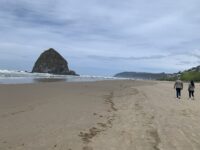Mile 313 Report
Tolovana Park north, Haystack Rock
March 23, 2018
A cold, beautiful day with hail on the beach and snow in low elevations on the western coast range visible from the beach.
Report Details
A cold, beautiful day with hail on the beach and snow in low elevations on the western coast range visible from the beach. About 50 people enjoying the beach, some tidepooling, a few walking/jogging. Many invertebrates washed ashore including dungeness crab, which gulls and crows were feeding on. Shifting sands have unearthed velella carcasses buried last year. A common murre carcass was found, likely preyed upon by a bald eagle earlier that day. At time of reporting (3/30), a large colony of sea lions (many dozen if not a hundred or so) was spotted just offshore and north of Haystack Rock rafting for several hours with their tails and flippers elevated above the water's surface. See photo. Peregrine falcon observed today (3/30) as well.
Conditions
Temperature: 34 F. Cloud Cover: Cloudy. Wind Velocity: Moderate. Wind Direction: SW. Tide Level: 1.5 feet.
Human Activities
Number of people: 51. Number of dogs: 3. Walking or running: 3. Tidepooling: 8. Not many people on the beach! Cold temps. A little bit of hail on and off, and snow up in the coastal peaks. Beautiful afternoon.
Concerns
Fire
Notable Wildlife
Gulls, black oystercatchers, cormorants, and murres. Domesticated/wild bunny under the willow on the sand in the vegetation line.
Beached Birds
Total dead birds: 2. One northern fulmar, one common murre. Fulmar was buried under sand, it's been shifting a lot recently with strong south winds. Fulmar mostly in tact, no leg bands. Common murre was recently killed, likely by bald eagle (probably earlier that day, as HRAP staff had noted eagles hunting that morning). Not much remaining beyond spine, wings and legs. See photo. No leg bands.
Dead Fish or Invertebrates
Not unusual, but notable dead invertebrates washed ashore: many salps, jelly fragments (probably moon jelly) & mole crabs. A few pyrosoma and scallop shells. One mysterious gelatinous remnant that we have seen in years past but couldn't determine what species from (see photo). I recall a pelagic sea snail as a possible ID. Lots of last year's vellela uncovered from recent sand movement. Lots of cellophane worm casings.
Driftline Content
Animal casings (e.g., crab, shrimp molt), Wood pieces, Ocean-based debris (from fishing boats, ship trash, etc.).
Natural Changes
Landslides/major boulder falls. Large chunks of the south-east wall of Haystack Rock fell down into the marine garden in January from winter storms.







Report Images
All Mile 313 Reports
Mile 313
Tolovana Park north, Haystack Rock
Beautiful day on the beach, cloudy and pleasant.
FOHRAP1
Mile 313
Tolovana Park north, Haystack Rock
A cloudy calm day on the beach with a few visitors.
FOHRAP1
Mile 313
Tolovana Park north, Haystack Rock
A beautiful beach day, with small numbers of people.
FOHRAP1
Mile 313
Tolovana Park north, Haystack Rock
A beautiful day on the beach today.
FOHRAP1
Mile 313
Tolovana Park north, Haystack Rock
Today was windy, mixed with rain.
FOHRAP1
Mile 313
Tolovana Park north, Haystack Rock
A cloudy day with intermittent mist, with comfortable temperatures and light human activity for a summer day made the mile walk very enjoyable.
FOHRAP1
Mile 313
Tolovana Park north, Haystack Rock
Most notable today was the lack of human activity.
FOHRAP1








